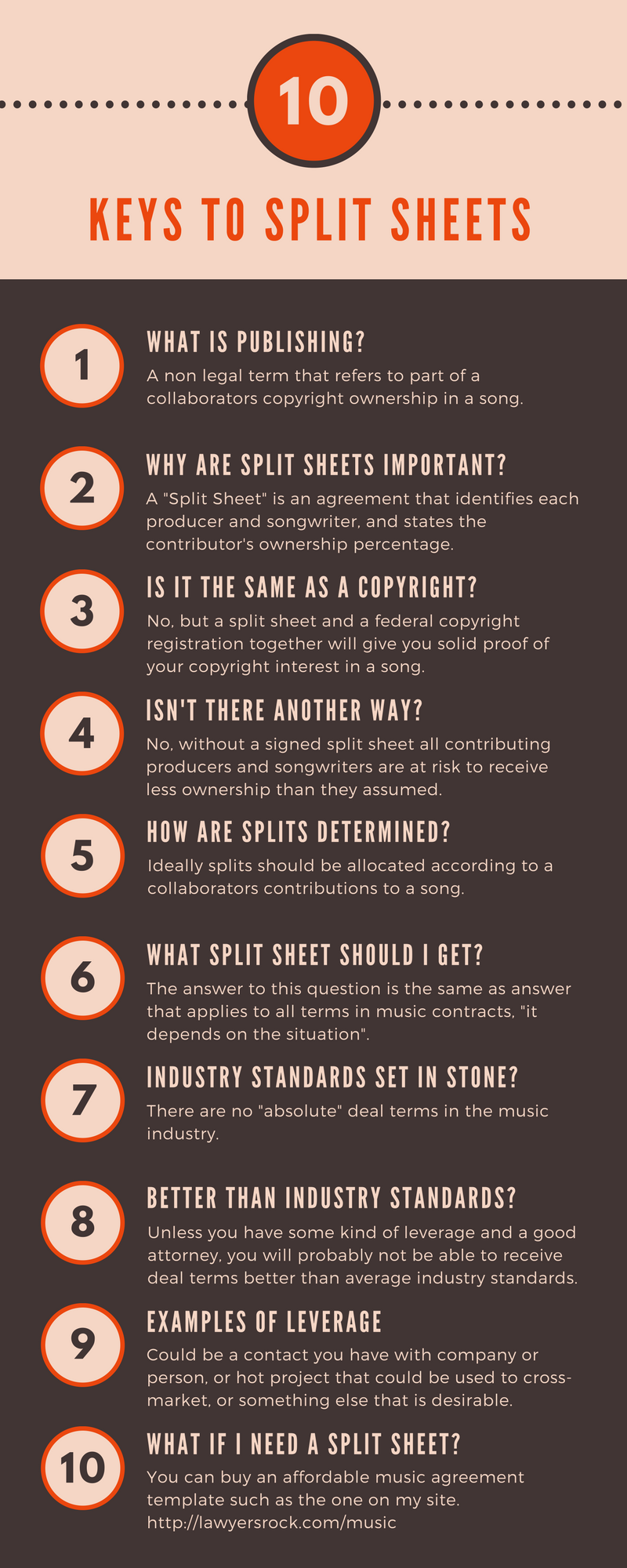Before I jump into today’s article I want to give you a super quick summary of the most important points about a Music Split Sheet.
If you want to know about additional musician waiver and release forms here is an article that details the whole package you should have.
The infographic below will give you a high-level overview of what you need to know while below that is the more detailed information.
And for every Music Professional, I always recommend you take a look at our affordable Music Agreement Packages.
It will teach you how to protect, brand and monetize your Music work, business or label.
Enjoy!
Infograph: Keys to Music Split Sheets In A Nutshell
Want to share this image on your site? Just copy and paste the embed code below:
Just like every other business that values the influence of social media, music producers and songwriters from different genres are collaborating with one another more than ever before to tap into each other’s social following.
Unless you are a super producer or songwriter like Pharrell Williams or Adam Levine, collaboration deals will likely follow the customary terms of the song’s genre.
This could be an unpleasant surprise if you are a hip hop producer who is crossing over to rock, country, or any other music genre because the producer will likely receive a smaller ownership percentage in the musical composition copyright, so it is important to know beforehand what to expect.
In today’s article/video I am going to teach you what you need to know about songwriter split sheets for music.
These are the most common questions I get on split sheets and the answers should remove some of the mystery surrounding this very important part of music agreements.
Please note that this post is specifically only about split sheet agreements.
For every Music Professional, I always recommend you take a look at our affordable Music Agreement Packages.
To get an overview of how split sheets work you can check out this video.
If you prefer full more detailed information the post version is below that.
The following are the most important questions for producers and writers to consider and some of my observations over the years, regarding customary industry standards in different genres.
What Exactly Is Publishing?
First, let’s start with a brief description of how copyright ownership relates to the frequently used term, “publishing”. This topic alone could be a blog by itself because it is frequently misunderstood.
Publishing is a non-legal term that is used to refer to part of a collaborator’s copyright ownership in a song.
The copyright in a song actually consists of two parts, a writer’s share (50%) and a publisher’s share (50%), but some people casually use the word to represent both shares.
Unless otherwise agreed to by the collaborators, a copyright owner is free to do whatever he or she wants with his or her portion of the song, such as assign it to a publishing company.
The primary benefit of owning part of a song is that it generates royalties and other income from single and album sales, radio play, music streaming, and licensing, which is why claiming your ownership of a song is so important.
Bottom line:
If you don’t understand the details of how publishing works, then make sure you have someone on your team who does or you could be missing out on money!
What Are Split Sheets And Why Are They Important?
A “split sheet” is an agreement that identifies each producer and songwriter, and states the contributor’s ownership percentage. The split sheet should include other important information as well, such as the contributors’ performing rights organization (ASCAP, BMI, SESAC, GMR), the specific contribution of each person (i.e., beats, melody, core lyrics, hook), and each person’s publisher information.
Also, it should indicate whether different versions of the song were created.
These details may not seem important in the early stages of creating a song, but a split sheet serves as evidence of copyright ownership and will assure a third party, such as a potential publisher or your PRO, that there are no disputes over splits.
Is a Split Sheet the Same Thing as Registering a Copyright Interest With the U.S. Copyright Office?
No. These are different.
A split sheet and a federal copyright registration together will give you solid proof of your copyright interest in a song.
One of the biggest mistakes that I see collaborating songwriters and producers make is failing to complete a simple split sheet because if the song becomes successful, which is the intent of all collaborations, then there is a risk that one of the contributors, or more likely his or her publisher, will claim that he or she should own a larger percentage of the song than originally assumed.
Also, under U.S. Copyright Law, if no agreement exists between the contributors, the default assumption is that all of the contributors jointly own an undivided equal share of a song.
This division may be acceptable in situations where the actual work was equal among the contributors, but that is not always true.
I Don’t Really Want to “Rock the Boat” During a Songwriting Session By Breaking Out a Contract. Isn’t There Another Way?
No. Without a signed split sheet all contributing producers and songwriters are vulnerable to receiving less of an ownership percentage than they assumed.
I recommend that the collaborators meet at a time and place outside of a creative session to discuss business and sign a split sheet.
A split sheet is also important because your administrator or accountant can use it to collect your royalties from record companies and your performing rights organization.
A record company and PRO may withhold all royalties generated by the song if the splits are not clear or a dispute exists because they don’t want to be liable.
How Are Splits Typically Determined?
In concept, splits should be allocated according to a collaborator’s contribution to a song.
Unfortunately, this is not a bright line concept because a contributor may believe that his or her contribution is more valuable to the final result than the other contributors may view it to be.
For example, if a song is divided up based on quantifiable measures, such as the lines of lyrics or music written, then a contributor who only wrote the hook to a song would only be entitled to about ten percent of the overall song.
The contributor who wrote the hook might not believe this method to be fair if the hook is frequently looped in the song and clearly raises the quality of the entire song, which is typical in hip hop.
There are countless examples like this so the bottom line is that all of the contributors need to come to an agreement.
What Split Should I Receive?
The true answer to this question is the same answer that applies to all terms in music contracts, “it depends on the situation”. With that said, I have seen the following rules of thumb:
In urban music (hip-hop/contemporary rhythm & blues), a producer is typically going to receive 50% of the song, less any portion allocated to existing samples, because the music significantly contributes to the success of a song, and the songwriters will split the remaining part.
To warrant such a large share, an urban producer is expected to not only deliver a finished master, as opposed to just beats, but to also manage the project and sometimes mentor the artist.
In the rock and pop genres (and old school R&B for catalog owners), a producer typically receives an equal share of all of the contributors based on the notion that the music and lyrics are equally important to the end result.
Rock and pop producers are also expected to help make the song successful by using their connections with industry professionals.
In country, a producer does not always share in copyright ownership unless the producer also contributes lyrics.
I have done deals where a producer receives a fee that is intended to compensate the producer for his or her efforts and buy out any rights, but I have noticed that Nashville publishers are not interested in dealing with producer contributors. It’s more songwriter focused.
Lastly, in the jazz and classical genres, producers rarely receive any copyright ownership in a song.
As you can see, if you are an urban producer you may not be interested in collaborating with certain other genres unless there is a promotional or other an ancillary benefit.
Are Industry “Standard” Splits Set In Stone?
There are no absolute deal terms in the music industry but unless you have some kind of leverage, you will probably not be able to receive deal terms much more favorable than the industry standards that I talk about above.
The term “leverage” is basically a strategic or tactical advantage over a contracting party, or you have something that the other person wants really bad so they want to work with you.
This could be a connection that you have with a company or person, an attractive upcoming project that could be used to cross-market, an impressive social media following, or something else that is desirable.
If you have leverage then the most effective way to use it is to have an experienced professional, such as a manager or attorney, maximize your deal terms. If strategically done, you will not offend the other party and end up with a great deal.
I hope you found this article on split sheets for music helpful.
As always please like, share or comment.
I have released high level music agreement templates at very reasonable prices including split sheets.


 So you’ve found the perfect name and branding for your business, registered the trademark with the USPTO, and now you’re ready to register the domain name.
So you’ve found the perfect name and branding for your business, registered the trademark with the USPTO, and now you’re ready to register the domain name.
